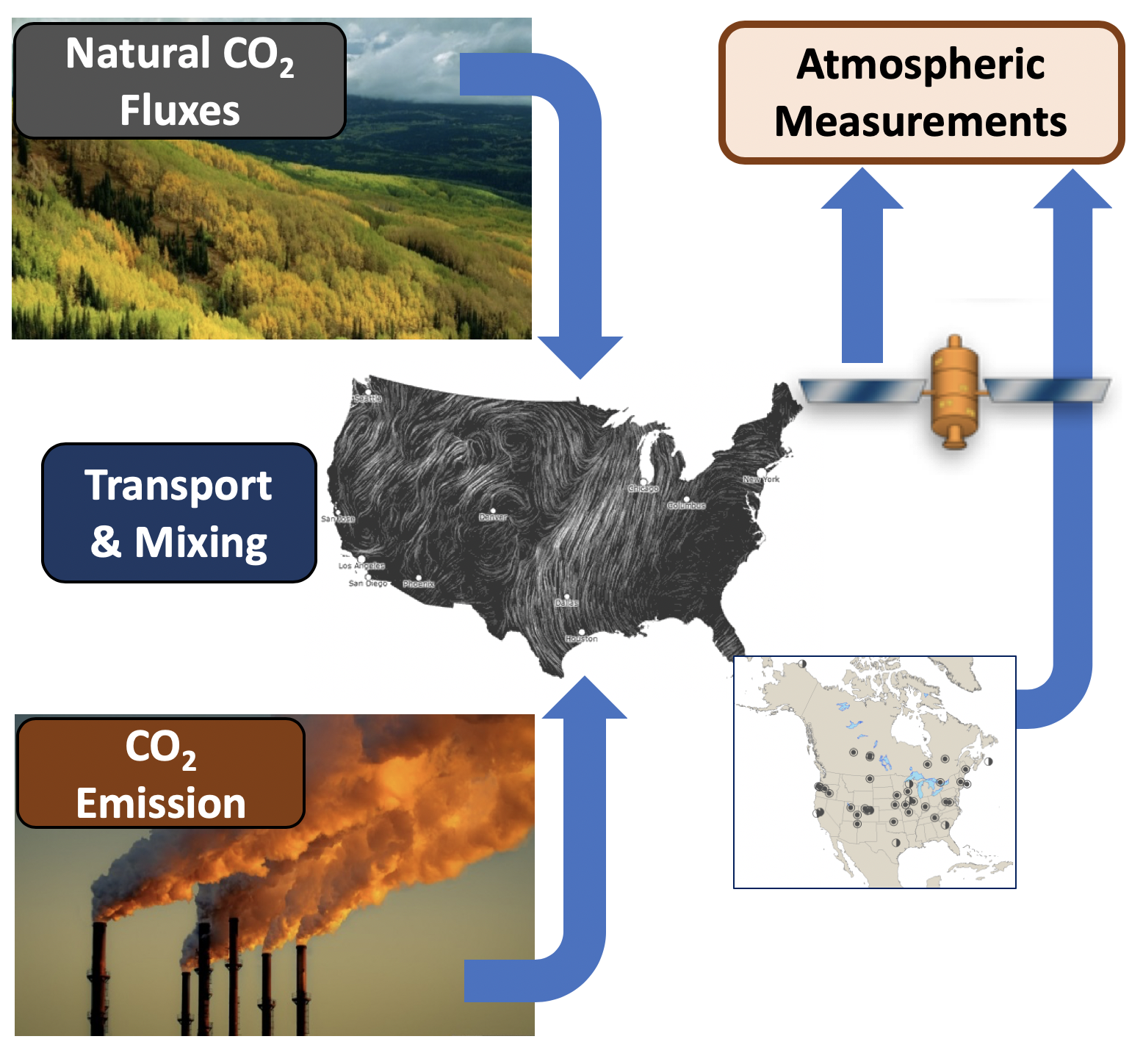Projects
Flux Inversion
At a Glance
Objective
Quantify fossil fuel and biogenic emissions of CO2 using prior information and all available in situ and remote sensing data. Disaggregating the biospheric and fossil fuel flux components of terrestrial fluxes from CO2 concentration measurements has proven to be difficult, due to observational and modeling limitations.Approach
We use a statistical inverse modeling scheme for disaggregating fluxes on the basis of their unique error covariances and covariates, where these covariances and covariates are representative of the underlying processes affecting fossil fuel and biospheric fluxes.Accomplishment
The application of the method has been demonstrated with one synthetic and two real data prototypical inversions by using in situ CO2 measurements over North America. The quality of disaggregation is assessed primarily through examination of a posteriori covariance between disaggregated FF and biospheric fluxes at regional scales. Findings indicate that the proposed method is able to robustly disaggregate fluxes regionally at monthly temporal resolution.
Selected Publications
Yadav, V, Duren, Riley, Mueller, Kim, Verhulst, Kristal R, Nehrkorn, Thomas and others (2019). “Spatio-temporally resolved methane fluxes from the Los Angeles Megacity,” Journal of Geophysical Research: Atmospheres, 124(9), pp. 5131–5148.
Ware, John, Kort, Eric A, Duren, Riley, Mueller, Kimberly L, Verhulst, Kristal, and Yadav, V (2019). “Detecting urban emissions changes and events with a near-real-time-capable inversion system,” Journal of Geophysical Research: Atmospheres.
He, Liyin, Zeng, Zhao-Cheng, Pongetti, Thomas J, Wong, Clare, Liang, Jianming and others (2019). “Atmospheric methane emissions correlate with natural gas consumption from residential and commercial sectors in Los Angeles,” Geophysical Research Letters, 46(14), pp. 8563–8571.
Cui, Yuyan, Vijayan, Abhilash, Falk, Matthias, Hsu, Ying-Kuang, Yin, Dazhong and others (2019). “A Multiplatform Inversion Estimation of Statewide and Regional Methane Emissions in California during 2014-2016,” Environmental Science & Technology, 53, pp.
Shiga, Yoichi P, Tadic, Jovan M, Qiu, Xuemei, Yadav, V, Andrews, Arlyn E and others (2018). “Atmospheric CO2 observations reveal strong correlation between regional net biospheric carbon uptake and solar-induced chlorophyll fluorescence,” Geophysical Research Letters, 45(2), pp. 1122–1132.
Gourdji, SM, Yadav, V, Karion, A, Mueller, KL, Conley, S and others (2018). “Reducing errors in aircraft atmospheric inversion estimates of point-source emissions: the Aliso Canyon natural gas leak as a natural tracer experiment,” Environmental Research Letters, 13(4), p. 045003, IOP Publishing.
Mueller, K, Yadav, V, Lopez-Coto, I, Karion, A, Gourdji, S and others (2018). “Siting background towers to characterize incoming air for urban greenhouse gas estimation: a case study in the Washington, DC/Baltimore area,” Journal of Geophysical Research: Atmospheres, 123(5), pp. 2910–2926.
Caroline B Alden, J. B. Miller, Luciana V. Gatti, Manuel Gloor, Kaiyu Guan and others (2016). “Regional atmospheric CO2 inversion reveals seasonal and geographic differences in Amazon net biome exchange,” Global change biology, 22(10), pp. 3427-43.
Yadav, V, Michalak, Anna M, Ray, Jaideep, and Shiga, Yoichi P (2016). “A statistical approach for isolating fossil fuel emissions in atmospheric inverse problems,” Journal of Geophysical Research: Atmospheres, 121(20), pp. 12–490.
Yadav, V and Michalak, Anna M (2016). “Improving the computational efficiency of sparse matrix multiplication in linear atmospheric inverse problems,” Geosci. Model Dev. Discuss, 204.
Ray, J, Lee, J, Yadav, V, Lefantzi, S, Michalak, AM and others (2015). “A sparse reconstruction method for the estimation of multi-resolution emission fields via atmospheric inversion,” Geoscientific Model Development, 8(4), pp. 1259–1273, Copernicus GmbH.
Ray, Jaideep, Yadav, V, Michalak, AM, van Bloemen Waanders, B, and Mckenna, Sean A (2014). “A multiresolution spatial parameterization for the estimation of fossil-fuel carbon dioxide emissions via atmospheric inversions,” Geoscientific Model Development, 7(5), pp. 1901–1918, Copernicus GmbH.
Yadav, V and Michalak, AM (2013). “Improving computational efficiency in large linear inverse problems: An example from carbon dioxide flux estimation,” Geoscientific Model Development, 6(3), pp. 583–590, Copernicus GmbH.
